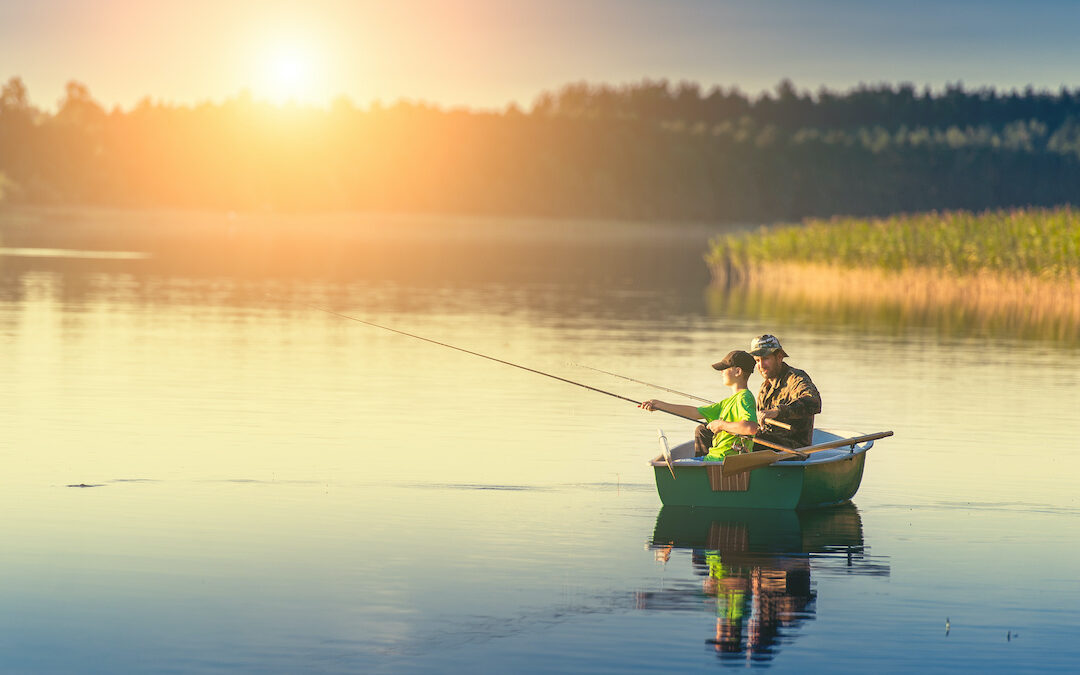Families gathered at the creeks on the first day of fishing season spark my hope that we as humans can heal our relationship to the natural world. Despite a challenging reality, there is so much beauty and love still to be found in our connection to nature.
The boy turned and smiled as he told me about the fish he’d just caught. A cute kid, about seven, with a wide, toothy grin, freckles and ears he’ll grow into. He and a woman, presumably his mom, wore rubber boots and had just loaded fishing poles and a net into their car.
I passed them near the lake at Greenwood Furnace State Park in central Pennsylvania.
Celebration was in the air. Parents brought their children to the lake that morning on the first Saturday of April to fish on Opening Day of Trout Season. Just after 10 a.m., two hours in, I asked him if he had caught a fish.
Yes, he answered, beaming.
A salmon, I think? he said.
No, said his mom, a trout! You caught a TROUT!
She chuckled and tousled his hair with her hand. Get in the car, she nudged.
It’s OK, I called out, smiling, as we walked on. You’ll learn their names!
Off they went. On I walked with our dogs past the picnic pavilions and toward the campground, feeling lighter and more hopeful after sharing that thrill of reeling in a fish.
A beautiful moment of a child enjoying an exciting connection with the natural world.
For me, a hopeful reminder that despite an urgent need for humans to find balance with nature, there is still so much beauty, love and comfort to be found in our connection to nature.
‘Guiding Lights’
Maybe this little boy will always remember catching that trout, the way I remember exploring the woods as a kid or turning over rocks near Tinker’s Creek within the Metroparks, an emerald network of wild places, woods and waterways that offer escapes from the housing developments and strip malls of suburban Cleveland, my hometown.
No single moment like this saves the world — and yet, they all matter because they can help us heal our collective relationship with nature.
These memories are “calling cards to the wholeness of a human lifetime, strongly rooted in your nature,” write social-psychologist Mary Clare and science writer Gary Ferguson in their excellent book “Full Ecology, Repairing Our Relationship with the Natural World.”
Short version: Our innate connection to nature means we can still heal that relationship. There is still time.
Clare and Ferguson’s message is a hopeful one that makes a lot of sense to me.
Their book begins with a photo of Mary Clare as a little girl, standing with her sister in a pond with water up to her shins, looking for tadpoles, then a picture of Gary Ferguson as a kid standing on the sandy shoreline of Lake Michigan feeding seagulls with his dad and brother as waves roll toward them.
These moments are guiding lights, they write.
“Guiding lights showing the way back to the landscape of your being. A homecoming, as uncomplicated and mysterious as tadpoles in an alpine pond or seagulls dancing above the dunes,” they write.
Everything is Better Outside
My love affair with the natural world began as a kid at the shallow Tinker’s Creek, where I learned everything is better outside, among the trees and the sound of water moving over rock.
My mom would pack up eggs, milk, cinnamon and bread, and kitchen gear. We’d spread out at a picnic table. She’d start a charcoal fire in the grill, then mix up the batter, soak the bread and cook a French toast breakfast for us on the griddle.
After breakfast, we’d pick our way along the creek, turning over rocks — even though I don’t remember much except feeling squeamish about what we might find. The joy was in the looking, the exploring.
We’d walk the trail through the woods to climb a big boulder.
Later, when I was in college and it was time for me to figure out where to live next, we walked together in the forest in New Hampshire’s White Mountains. On that trip, I realized people could live within big, wild, natural places — where the forest or the mountain or the sea was a constant, dominating presence more powerful than freeways and parking lots and shopping malls. I wanted that life.
First Assignment: Heartbreaking Loss
I chose Maine for the water. Almost every turn on my first drive in Maine took me to a lake or river and eventually the ocean. Soon, I had my first pro-writer job, telling the stories of Maine fishermen.
The iconic cod stocks off the New England coast, so key to colonial America, were crashing and no one really fully understood why. The scientists said it was too much fishing. The fishermen said the scientists were poor fishermen and didn’t know where to look for fish.
Turns out Atlantic cod is likely one of the early losses to climate change in the Gulf of Maine, which is warming faster than 99 percent of the global ocean. Those rising temperatures are pushing many species north and there is much concern about when the waters will become too warm for Maine lobster.
So began my three decades and counting, of researching and telling stories about our human relationship to nature, often through the lens of fishing, gardening, farming, or eating. All ecological acts. All connecting points to the natural world.
Intimate Connection
Now, I live in Pennsylvania, with thick forests and dark, swirling trout streams that draw fly fishermen from all over the world.
I have long believed that conservation isn’t so much about “saving the environment” — this other, separate thing — but to save our own life-support system, to save ourselves.
We eat. We breathe. We drink water. We cope with or bask in the weather. We fish. We garden. We walk in the woods. We go to the beach to have fun and relax. We are all intimately connected to nature every day, whether we think of ourselves as outdoorsy — or not.
We’re also already living in the midst of climate change.
Seeking Woods and Water
So I come to the park to walk, to get out of my head and refresh my spirit among the woods and water.
I felt joy to be in a place awash in spring light, to see the forest floor wake up with green, to see so many little groups of families fishing and camping together.
This place with its lake and meadow of wildflowers, trails through the woods, memories and old stone buildings never fails to inspire me. It is a symbol of healing.
The house, the Ironmaster’s Mansion, is a remnant of the buildings and community that sprouted here to support the iron-making operation that peaked in the early 1880s. The stone furnaces blasted iron ore into pig iron ingots hauled away to become wrought iron. Charcoal made from the burned wood of cut trees fueled the furnaces. Read the history here.
About a century ago, Pennsylvania cut most of its forests to the ground. Now we have 2.2 million acres of state forest here, helping to clean and protect our air and water.
By 1842, a dam and spillway was built to create the lake to supply water and power to a gristmill.
The same lake now stocked with trout.
To see people delight in nature leaves me hopeful that we can heal our connection — and give this kid and all of our kids a much better shot at a full, healthy and peaceful life.

